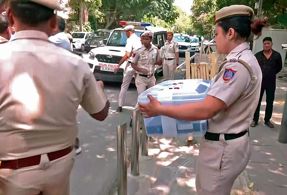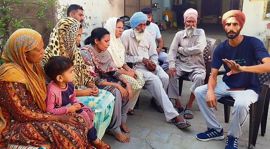
Photo for representational purpose only. File photo
Tikender Singh Panwar
Over the past few days, the ongoing tussle between the agitating people of Bilaspur district against the proposed Ali Khud water scheme that is going to benefit a few villages in Solan district has been a regular feature in the media.
There have been agitations since last month, also being supported by environment groups, indicting the Jal Shakti Department for designing a water scheme to benefit the Adani group running a cement plant at Darlaghat in Solan district. However, people from Solan panchayats have been demanding this scheme, saying it will give them safe drinking water. It is stated that there are over 24 drinking water schemes downstream that shall be affected if water is pumped from the Ali Khud.
Similar hostility occurred between the JP University management and people living along the Gambar river not allowing the varsity to lift water from it. Even the MES water station at Subathu pumping water to Dagshai opposed the university’s proposal, as it feared that the water source would be affected. Riparian rights and claims are often contested and most of the time land up in strong civil unrest. Thanks to the recent amendments brought to the Water Policy and subsequent Water Act of 2023, the situation is going to worsen and there may be an accentuation of such a strife and contestations.
According to the Asian Development Bank (ADB) rural water project in HP, the state has a coverage of 75.5% population with piped water, but still a large population is to be reached. The document states, “Despite a relatively high access rate, the existing rural water supply infrastructure is in a poor condition and the service level is low. This is the result of ageing infrastructure and the absence of an overall asset management framework, exacerbated by a lack of operation and maintenance (O&M) funding. The existing water supply is intermittent at six–eight hours per day, with an average of 40 litres per capita per day.”
In an already unpleasant situation, the shift in government policy could lead to civil unrest and law and order problems as well. However, here the most precipitating issue that will be demanding immediate redress is based on following counts like climate change and its impact.
The 2023 floods in Himachal are just a stark reminder of many more to come. Such a situation will further mount pressure on the existing infrastructure and, at times, will affect water sources by flooding, and, at times, long dry periods. Climate-resilient infrastructure must be built.
The state is under massive shift in agro-horticulture patterns. The shift is taking place from conventional varieties to “high-density spur” varieties of apple. In the Himalayan layers, the water table is not uniform but hydrology depends upon the geology of rocks underneath. Surface springs are coming out of hard rocks that have a water-retention capacity. With borewells, the water channels are intercepted, leading to the loss of water to the downstream population. This is going to be a major reason for conflict in future.
Likewise, cash crops, mainly in vegetable growing areas, are also in this transition phase. The amendment made to the Himachal Pradesh Groundwater (Regulation and Control of Development and Management) Act 2022, seems to have been influenced by rich farmers and the hospitality industry that is rampantly digging borewells, primarily in Solan, Shimla, Kullu and Kangra.
The amendment has allowed borewells to individuals: farmers, hotel owners, and even MSMEs. An equal number of borewells are dug without permission from government agencies.
More people to be covered
- As per Asian Development Bank, the state has a coverage of 75.5% population with piped water, but still a large population is to be reached
- Despite a relatively high access rate, the existing rural water supply infrastructure is in a poor state and the service level is low
- This is due to ageing infrastructure and the absence of an overall asset management framework, worsened by the lack of operation and maintenance funding
(The writer is a former Deputy Mayor of Shimla)
Join Whatsapp Channel of The Tribune for latest updates.



























